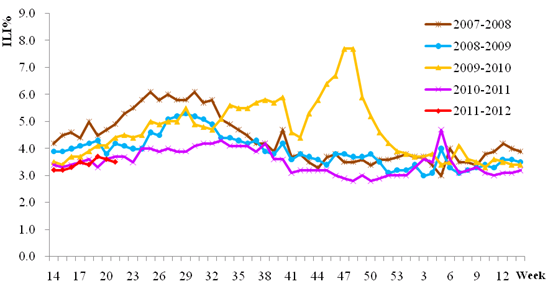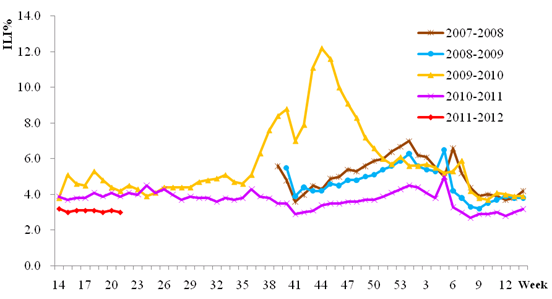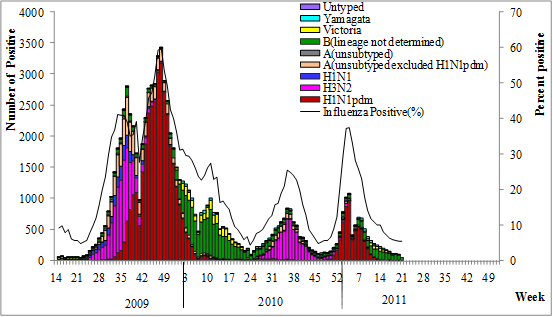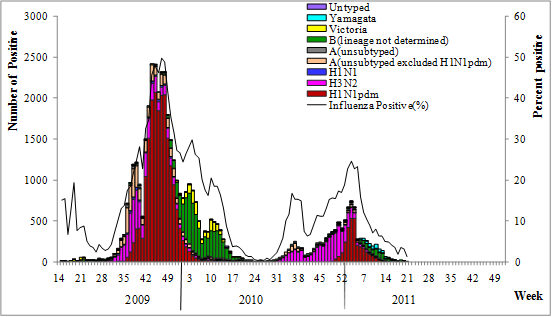Weekly Report
Week 21 2011
Article source: Date time:2011-08-02
Download:1.pdf
|
Summary
|
Pandemic (H1N1) 2009 Surveillance
During week 21, 2 confirmed cases of pandemic influenza H1N1 2009 were reported from 2 provinces (municipality/autonomous region), which were 11 cases less than that of week 20 (13 cases). In this week, no critical or death case was reported. During January 1- May 29, 2011, 8518 confirmed cases, 243 severe cases (including 118 critical cases) and 70 deaths of pandemic influenza H1N1 2009 have been reported nationwide.
(Note: After cases are reported to the system, the information would be checked by local CDC at all levels to ensure accuracy. From week 3, 2010, data collected in the weekly report refers to the information after examination.)
Outbreak Surveillance
During week 21, no outbreak of seasonal influenza was reported.
Influenza-like Illness (ILI) Surveillance
During week 21, the percentage of visits with ILI (ILI%) of sentinel hospitals in south China was 3.5%, which was slightly lower than that of week 20 (3.6%). It was lower than the level seen during the same period of the previous year (3.7%). Since week 10, 2011, the ILI% has showed an increasing trend (Figure 1).

Figure 1. Percentage of Visits for ILI of Sentinel Hospitals in South China (2007-2011)
During week 21, the ILI% of sentinel hospitals in north China was 3.0%, which was slightly lower than that of week 20 (3.1%). It was lower than the level seen during the same period of previous years (Figure 2).

Figure 2. Percentage of Visits for ILI of Sentinel Hospitals in North China (2007-2011)
Virologic Surveillance
During week 21, network laboratories tested 1040 specimens, of which 50 (4.8%) were positive for influenza, and influenza B (96.0%) was predominant. During week 21, the percentage of tests that were positive for influenza in south China was 5.5%, which was the same as that of the previous week (5.5%). The percentage of tests that were positive for influenza in north China was 1.2%, which was lower than that of the previous week (3.1%) (Detailed information of influenza laboratory detections of south and north China is shown as Table 1).
Table 1 Laboratory Detections of ILI Specimens
|
Week 21 |
|||
|
South China |
North China |
Total |
|
|
No. of specimens tested |
876 |
164 |
1040 |
|
No. of positive specimens (%) |
48(5.5%) |
2(1.2%) |
50(4.8%) |
|
Influenza A |
2(4.2%) |
0(0) |
2(4%) |
|
A (H1N1) |
0(0) |
0(0) |
0(0) |
|
A (H3N2) |
1(50.0%) |
0(0) |
1(50.0%) |
|
A (pandemic influenza H1N1 2009 excluded)[1] |
1(50.0%) |
0(0) |
1(50.0%) |
|
Pandemic influenza H1N1 2009 |
0(0) |
0(0) |
0(0) |
|
A (pandemic influenza H1N1 2009 not excluded)[2] |
0(0) |
0(0) |
0(0) |
|
Influenza B |
46(95.8%) |
2(100%) |
48(96.0%) |
|
B (lineage not determined) |
46(100%) |
2(100%) |
48(100%) |
During week 1 - 10, 2011 (January 3- March 13, 2011), pandemic influenza H1N1 2009 virus was the predominant strain in both south and north China. Since week 11, the percentage of influenza B exceeded that of pandemic influenza H1N1 2009 and other influenza A subtype and became the predominant strain.

Figure 3. Influenza positive tests reported by southern network laboratories (Week 14, 2009 –Week 21, 2011)
Note:

Figure 4. Influenza positive tests reported by northern network laboratories (Week 14, 2009 –Week 21, 2011)
Note:
Antigenic Characterization
During week 21, CNIC has antigenically characterized 93 pandemic influenza H1N1 2009 viruses. 75 (80.6%) of them are related to A/California/7/2009-like; 18 (19.4%) of them demonstrate reduced titers (≥8 fold lower in HI titer) with anti-sera produced against A/California/7/2009.
During week 21, CNIC has antigenically characterized 4 influenza A(H3N2) viruses. 4 (100%) of them are related to A/Perth/16/2009(H3N2)-like.
During week 21, CNIC has antigenically characterized 95 influenza B/Victoria viruses. 95 (100.0%) of them are related to B/Brisbane/60/2008-like.
During week 21, CNIC has antigenically characterized 72 influenza B/Yamagata viruses. 60 (83.3%) of them are related to B/Florida/4/2006-like; 12 (16.7%) demonstrate reduced titers (≥8 fold lower in HI titer) with anti-sera produced against B/Florida/4/2006.
During January 1 - May 29, 2011, CNIC has antigenically characterized 1357 pandemic influenza H1N1 2009 viruses. 1304 (96.1%) of them are related to A/California/7/2009-like; 53 (3.9%) demonstrate reduced titers (≥8 fold lower in HI titer) with anti-sera produced against A/California/7/2009.
During January 1 - May 29, 2011, CNIC has antigenically characterized 116 influenza A(H3N2) viruses. 112 (96.6%) are related to A/Perth/16/2009(H3N2)-like; 4 (3.4%) demonstrate reduced titers (≥8 fold lower in HI titer) with anti-sera produced against A/Perth/16/2009(H3N2).
During January 1 - May 29, 2011, CNIC has antigenically characterized 422 influenza B/Victoria viruses. 374 (88.6%) are related to B/Brisbane/60/2008-like; 48 (11.4%) demonstrate reduced titers (≥8 fold lower in HI titer) with anti-sera produced against B/Brisbane/60/2008.
During January 1 - May 29, 2011, CNIC has antigenically characterized 577 influenza B/Yamagata viruses. 327 (56.7%) are related to B/Florida/4/2006-like; 250 (43.3%) demonstrate reduced titers (≥8 fold lower in HI titer) with anti-sera produced against B/Florida/4/2006.
During January 1 - May 29, 2011, CNIC has sequenced 38 pandemic influenza H1N1 2009 viruses. All the viruses have high homology (>98%) with the A/California/7/2009(H1N1) reference virus selected by WHO and the A/Sichuan/SWL1/2009 reference virus in mainland China. Only 1 virus possesses mutation at the NA gene at amino acid position 274 and is resistant to the neuraminidase inhibitors. The significance of mutations at other amino acid positions is still unclear.
Antiviral Resistance
During week 21, 2011, all the 9 pandemic influenza H1N1 2009 viruses and the 7 influenza A(H3N2) viruses tested by CNIC are resistant to adamantine and sensitive to the neuraminidase inhibitors. All the 51 influenza B viruses tested are sensitive to neuraminidase inhibitors.
During January 1 - May 29, 2011, all pandemic influenza H1N1 2009 viruses tested by CNIC are resistant to adamantine; only 1 virus is resistant to the neuraminidase inhibitors, others are still sensitive to the neuraminidase inhibitors. All influenza A (H3N2) viruses are resistant to adamantine and sensitive to neuraminidase inhibitors. All influenza B viruses are sensitive to neuraminidase inhibitors.

